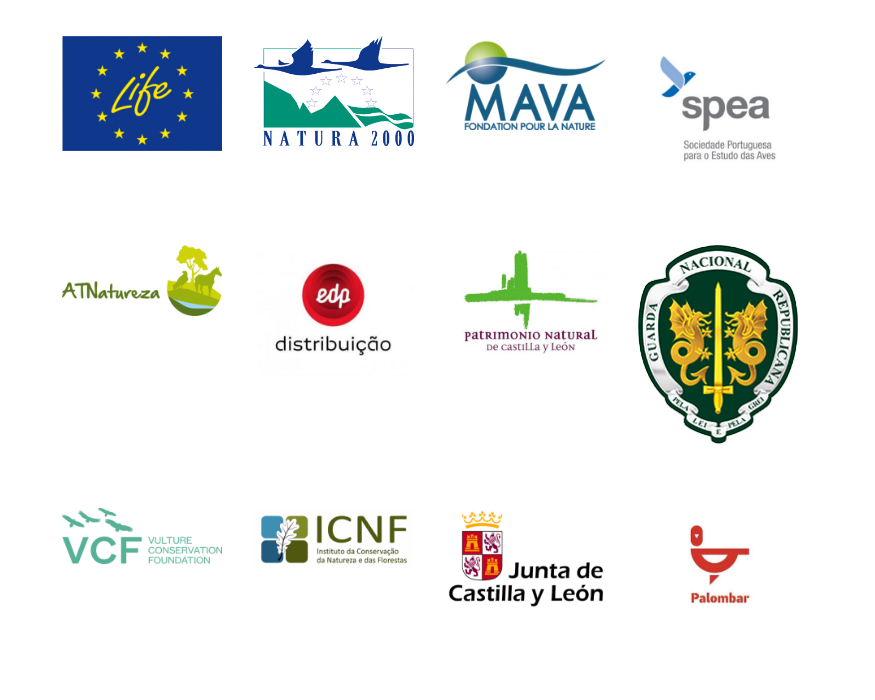Egyptian Vultures at Lamoso © Palombar

| Initiative period | July 2015 to December 2020 |
|---|---|
| Initiative area | Portugal and Spain – Douro Canyon |
| Target species | Egyptian and Cinereous Vultures |
The LIFE Rupis conservation project aims to strengthen the populations of the Egyptian Vulture and Bonelli’s Eagle, as well as the Cinereous Vulture in the Douro Canyon that borders Portugal and Spain.
Europe’s smallest vulture, the Egyptian Vulture is classified as ‘Endangered’ according to the International Union for the Conservation of Nature (IUCN). Over the last 40 years, its numbers have decreased by over 50%. While Europe’s other three vulture species show an increasing population trend across the continent, the Egyptian Vulture continues to decrease in numbers. The largest population of this species can be found on the Iberian Peninsula, and the cross border Douro Canyon is one of its strongholds with an estimated 135 breeding pairs.
We’re working with our partners to carry out actions in the Douro Canyon to tackle threats these birds face, helping to reduce mortality and increase their breeding success.
LEARN ABOUT THE TARGET SPECIES
With funding from the European Union’s LIFE programme and the MAVA Foundation, we’ve been working alongside the project lead partner, Sociedade Portuguesa para o Estudo das Aves (SPEA), since 2015 to carry out a range of conservation actions to tackle the threats we’ve identified as well as carefully tracking the movements of the migratory Egyptian Vulture during the breeding season in Europe, along its migration route and in its overwintering grounds in sub-Saharan Africa.
MONITORING
Each year the Egyptian Vultures of the Douro Canyon travel over 7,000 km between their summer and winter grounds in sub-Saharan Africa. To better understand their travels and the potential threats they encounter, we have been fitting birds with small satellite tracking devices to monitor their movement. These devices usually last between three and five years and send location data over the mobile communications network and using this information we are able to identify the areas they use to feed in the Douro Canyon and their migration routes to their winter grounds. Follow the Egyptian Vultures released we have tagged with our online maps.

IMPROVING FOOD AVAILABILITY
One of the issues facing Egyptian Vultures across the Douro Canyon is a reduction in the availability of food. Our partners are setting up a network of feeding stations with donations of animal by-products from local butchers to supplement their food supplies they find in the wild. The project team are also creating a set of recommendations for local livestock owners to improve the availability of food for vultures based on evaluation of European Union health regulation on the disposal of dead animals.

TACKLING THREATS
Two of the major threats facing Egyptian Vultures in the Douro Canyon are illegal wildlife poisoning and electrocution. Working with the GNR, Portugals national police force, we have established two anti-poisoning canine units comprised of a dog highly trained to detect dead animals and poisoned baits and handler. This unit is being used to patrol the area to establish a poison-free area by controlling and removing poisoned baits before they can negatively impact local wildlife. We have also established a set of protocols for the collection and identification of toxic substances that help establish cases of illegal wildlife poisoning. We are also collaborating with energy company EDP Distribuição to help reduce deaths of vultures caused by electrocution when birds perch on low or medium tension powerlines by insulating the most high-risk cables.

LIFE Rupis is a partnership between the Sociedade Portuguesa para o Estudo das Aves (SPEA), Associação Transumância e Natureza, EDP Distribuição, Fundación Patrimonio Natural de Castilla y León, Guarda Nacional Republicana (GNR), Instituto da Conservação da Natureza e das Florestas (ICNF), Junta de Castilla y León and Palombar – Associação da Conservação da Natureza e do Património Rural and the Vulture Conservation Foundation.
For more information, visit the Rupis website


